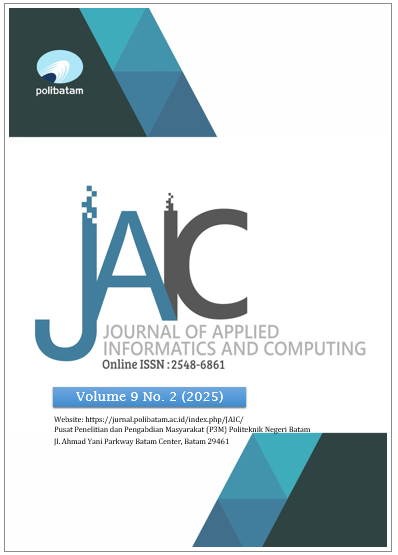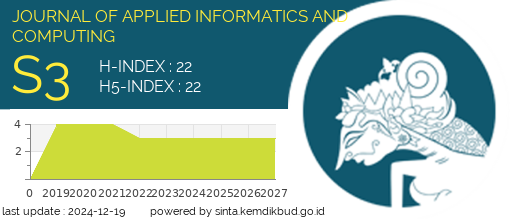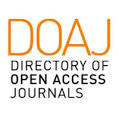Comparative Study of the ARIMA Method and Multiple Linear Regression in Metro City Population Growth Projections
DOI:
https://doi.org/10.30871/jaic.v9i2.9097Keywords:
Population Growth, Multiple Linear Regression, ARIMA, Population Projection, Development PlanningAbstract
This study aims to compare the effectiveness of the ARIMA (Autoregressive Integrated Moving Average) method and multiple linear regression in projecting population growth in Metro City, Lampung. The analysis utilizes population data from 2010 to 2022, sourced from the Central Statistics Agency and the Population and Civil Registration Office. The methodologies employed include ARIMA modelling and multiple linear regression, with model evaluation conducted using metrics such as Mean Absolute Percentage Error (MAPE) and Root Mean Square Error (RMSE). The findings indicate that the multiple linear regression model predicts an average population growth of 2,200 individuals per year, resulting in a total projection of 185,032 by 2030. In contrast, the ARIMA (2,1,1) model forecasts a total population of 169,500 for the same year. The conclusion drawn from this research suggests that while both methods possess distinct advantages, ARIMA is more effective in capturing seasonal patterns and long-term trends, whereas multiple linear regression offers greater interpretability. This study recommends the complementary use of both methods to enhance the accuracy of population growth projections.
Downloads
References
[1] K. Dai, S. Shen, dan C. Cheng, “Evaluation and analysis of the projected population of China,” Sci Rep, vol. 12, no. 1, hlm. 3644, Mar 2022, doi: 10.1038/s41598-022-07646-x.
[2] K. Dai, S. Shen, dan C. Cheng, “Evaluation and analysis of the projected population of China,” Sci Rep, vol. 12, no. 1, hlm. 3644, Mar 2022, doi: 10.1038/s41598-022-07646-x.
[3] E. Bossone, B. Ranieri, E. Coscioni, dan R. R. Baliga, “Community health and prevention: It takes a village to reduce cardiovascular risk! Let us do it together!,” Eur J Prev Cardiolog, vol. 26, no. 17, hlm. 1840–1842, Nov 2019, doi: 10.1177/2047487319867505.
[4] The Lancet, “Measuring the future of humanity for health,” The Lancet, vol. 400, no. 10347, hlm. 137, Jul 2022, doi: 10.1016/S0140-6736(22)01326-5.
[5] R. Agmadeni, “Analysis of Lampung Export Value 2015-2023 with The Arima Method Approach (Autoregressive Integrated Moving Average),” income, vol. 3, no. 3, hlm. 24–28, Agu 2024, doi: 10.32764/income.v3i3.5031.
[6] E. P. Butar-Butar dan M. L. Siahaan, “Metode Regresi Linear Berganda dalam Mengestimasi Laju Pertumbuhan Penduduk pada BPS Serdang Bedagai,” vol. 1, no. 2, 2024.
[7] Y. Farida, M. Farmita, N. Ulinnuha, dan D. Yuliati, “Forecasting Population of Madiun Regency Using ARIMA Method,” CAUCHY, vol. 7, no. 3, hlm. 420–431, Okt 2022, doi: 10.18860/ca.v7i3.16156.
[8] Candra Adi Rahmat, Kurniabudi, dan Y. Novianto, “Penerapan Metode Regresi Linier BergandaUntuk Mengestimasi Laju Pertumbuhan Penduduk Kabupaten Musi Banyuasin,” JAKAKOMUNAMA, vol. 3, no. 1, hlm. 359–369, Apr 2023, doi: 10.33998/jakakom.2023.3.1.732.
[9] Y. K. Pandu, “Prediksi Penduduk Kabupaten Alor Dengan Menggunakan Model Pertumbuhan Logistik Pada Beberapa Tahun Mendatang,” Jurnal Kependidikan Matematika, vol. 2, no. 1, hlm. 71–81, Mei 2020, doi: 10.30822/asimtot.v2i1.502.
[10] K. Li, “Prediction of atmospheric temperature in Sacramento area based on ARIMA and ETS models,” TNS, vol. 51, no. 1, hlm. 165–171, Nov 2024, doi: 10.54254/2753-8818/51/2024CH0197.
[11] G. Darmawan, D. Rosadi, dan B. N. Ruchjana, “Hybrid Model of Singular Spectrum Analysis and ARIMA for Seasonal Time Series Data,” CAUCHY, vol. 7, no. 2, hlm. 302–315, Mar 2022, doi: 10.18860/ca.v7i2.14136.
[12] Y. Huang, “Comparison Of 6 Machine Learning Models in Estimating Population Growth,” HSET, vol. 85, hlm. 519–523, Mar 2024, doi: 10.54097/h97nwj92.
[13] Farhanuddin, Sarah Ennola Karina Sihombing, dan Yahfizham, “Komparasi Multiple Linear Regression dan Random Forest Regression Dalam Memprediksi Anggaran Biaya Manajemen Proyek Sistem Informasi,” JCBD, vol. 3, no. 2, hlm. 86–97, Mei 2024, doi: 10.56427/jcbd.v3i2.408.
[14] S. S Kulkarni, S. R Kulkarni, dan S. J Patil, “Prediksi Jumlah Penduduk Kalimantan Selatan Menggunakan Metode Nonlinear Least-Squares,” IJIRSET, vol. 03, no. 09, hlm. 15843–15850, Sep 2014, doi: 10.15680/IJIRSET.2014.0309008.
[15] D. S. Seruni, M. T. Furqon, dan R. C. Wihandika, “Sistem Prediksi Pertumbuhan Jumlah Penduduk Kota Malang menggunakan Metode K-Nearest Neighbor Regression”.
[16] K. Albeladi, B. Zafar, dan A. Mueen, “Time Series Forecasting using LSTM and ARIMA,” IJACSA, vol. 14, no. 1, 2023, doi: 10.14569/IJACSA.2023.0140133.
[17] G. Kaur, “Theoretical Investigation On Mathematical Modelling On Population Growth,” vol. 6, no. 2, 2019.
[18] X. Jiang, “Forecasting urban unemployment rate in China using ARIMA model,” TNS, vol. 51, no. 1, hlm. 142–148, Nov 2024, doi: 10.54254/2753-8818/51/2024CH0191.
[19] Zul Ihsan Mu’arrif, “Forecasting Market Capitalization on The Jakarta Islamic Index using The Arima Method,” RESLAJ, vol. 6, no. 6, Jun 2024, doi: 10.47467/reslaj.v6i6.2423.
[20] T. S. Nguyen dan C. C. Pham, “Empirical Evaluation of the Time Series Forecasting Method by Combining ARIMA with RBFNN under the Additive Model,” JTE, vol. 19, no. 1, hlm. 1–7, Feb 2024, doi: 10.54644/jte.2024.1520.
[21] Y. Wang, Y. Zhang, Y. Zhou, dan W. Tang, “Road Condition Prediction Based on ARIMA Algorithm,” HSET, vol. 92, hlm. 403–410, Apr 2024, doi: 10.54097/zwypra61.
[22] P. Kurniawan dkk., “Prediksi Jumlah Penduduk Jakarta Selatan Menggunakan Metode Regresi Linear Berganda,” justin, vol. 10, no. 4, hlm. 518, Des 2022, doi: 10.26418/justin.v10i4.48331.
[23] F. O. Lusiana, I. Fatma, dan A. P. Windarto, “Estimasi Laju Pertumbuhan Penduduk Menggunakan Metode Regresi Linier Berganda Pada BPS Simalungun,” jimat, vol. 1, no. 2, hlm. 79–84, Apr 2021, doi: 10.47065/jimat.v1i2.104.
[24] V. Kramar dan V. Alchakov, “Time-Series Forecasting of Seasonal Data Using Machine Learning Methods,” Algorithms, vol. 16, no. 5, hlm. 248, Mei 2023, doi: 10.3390/a16050248.
[25] I. Kurniawan, N. Rahaningsih, dan T. Suprapti, “Implementasi Algoritma Regresi Linier dan K-Nearest Neighbor Untuk Prediksi Harga Rumah,” jati, vol. 8, no. 1, hlm. 1187–1193, Mar 2024, doi: 10.36040/jati.v8i1.8402.
[26] Y. Gu, “Underlying factors for gold price prediction based on ARIMA models,” ACE, vol. 101, no. 1, hlm. 147–153, Nov 2024, doi: 10.54254/2755-2721/101/20240993.
[27] S. Garner, Y. Pan, dan M. Shi, “Amazon’s Stock Trends Prediction based on ARIMA Model,” HBEM, vol. 35, hlm. 58–64, Jun 2024, doi: 10.54097/g3yrh896.
Downloads
Published
How to Cite
Issue
Section
License
Copyright (c) 2025 Tri Aristi Saputri, Allien Moetiara Rachma Ajiz, Dani Febritama

This work is licensed under a Creative Commons Attribution-ShareAlike 4.0 International License.
Authors who publish with this journal agree to the following terms:
- Authors retain copyright and grant the journal right of first publication with the work simultaneously licensed under a Creative Commons Attribution License (Attribution-ShareAlike 4.0 International (CC BY-SA 4.0) ) that allows others to share the work with an acknowledgement of the work's authorship and initial publication in this journal.
- Authors are able to enter into separate, additional contractual arrangements for the non-exclusive distribution of the journal's published version of the work (e.g., post it to an institutional repository or publish it in a book), with an acknowledgement of its initial publication in this journal.
- Authors are permitted and encouraged to post their work online (e.g., in institutional repositories or on their website) prior to and during the submission process, as it can lead to productive exchanges, as well as earlier and greater citation of published work (See The Effect of Open Access).











